Rizwan Ali Naqvi
Deep Perceptual Enhancement for Medical Image Analysis
Mar 11, 2025Abstract:Due to numerous hardware shortcomings, medical image acquisition devices are susceptible to producing low-quality (i.e., low contrast, inappropriate brightness, noisy, etc.) images. Regrettably, perceptually degraded images directly impact the diagnosis process and make the decision-making manoeuvre of medical practitioners notably complicated. This study proposes to enhance such low-quality images by incorporating end-to-end learning strategies for accelerating medical image analysis tasks. To the best concern, this is the first work in medical imaging which comprehensively tackles perceptual enhancement, including contrast correction, luminance correction, denoising, etc., with a fully convolutional deep network. The proposed network leverages residual blocks and a residual gating mechanism for diminishing visual artefacts and is guided by a multi-term objective function to perceive the perceptually plausible enhanced images. The practicability of the deep medical image enhancement method has been extensively investigated with sophisticated experiments. The experimental outcomes illustrate that the proposed method could outperform the existing enhancement methods for different medical image modalities by 5.00 to 7.00 dB in peak signal-to-noise ratio (PSNR) metrics and 4.00 to 6.00 in DeltaE metrics. Additionally, the proposed method can drastically improve the medical image analysis tasks' performance and reveal the potentiality of such an enhancement method in real-world applications. Code Available: https://github.com/sharif-apu/DPE_JBHI
Illuminating Darkness: Enhancing Real-world Low-light Scenes with Smartphone Images
Mar 10, 2025Abstract:Digital cameras often struggle to produce plausible images in low-light conditions. Improving these single-shot images remains challenging due to a lack of diverse real-world pair data samples. To address this limitation, we propose a large-scale high-resolution (i.e., beyond 4k) pair Single-Shot Low-Light Enhancement (SLLIE) dataset. Our dataset comprises 6,425 unique focus-aligned image pairs captured with smartphone sensors in dynamic settings under challenging lighting conditions (0.1--200 lux), covering various indoor and outdoor scenes with varying noise and intensity. We extracted and refined around 180,000 non-overlapping patches from 6,025 collected scenes for training while reserving 400 pairs for benchmarking. In addition to that, we collected 2,117 low-light scenes from different sources for extensive real-world aesthetic evaluation. To our knowledge, this is the largest real-world dataset available for SLLIE research. We also propose learning luminance-chrominance (LC) attributes separately through a tuning fork-shaped transformer model to enhance real-world low-light images, addressing challenges like denoising and over-enhancement in complex scenes. We also propose an LC cross-attention block for feature fusion, an LC refinement block for enhanced reconstruction, and LC-guided supervision to ensure perceptually coherent enhancements. We demonstrated our method's effectiveness across various hardware and scenarios, proving its practicality in real-world applications. Code and dataset available at https://github.com/sharif-apu/LSD-TFFormer.
Two-stage Deep Denoising with Self-guided Noise Attention for Multimodal Medical Images
Mar 10, 2025Abstract:Medical image denoising is considered among the most challenging vision tasks. Despite the real-world implications, existing denoising methods have notable drawbacks as they often generate visual artifacts when applied to heterogeneous medical images. This study addresses the limitation of the contemporary denoising methods with an artificial intelligence (AI)-driven two-stage learning strategy. The proposed method learns to estimate the residual noise from the noisy images. Later, it incorporates a novel noise attention mechanism to correlate estimated residual noise with noisy inputs to perform denoising in a course-to-refine manner. This study also proposes to leverage a multi-modal learning strategy to generalize the denoising among medical image modalities and multiple noise patterns for widespread applications. The practicability of the proposed method has been evaluated with dense experiments. The experimental results demonstrated that the proposed method achieved state-of-the-art performance by significantly outperforming the existing medical image denoising methods in quantitative and qualitative comparisons. Overall, it illustrates a performance gain of 7.64 in Peak Signal-to-Noise Ratio (PSNR), 0.1021 in Structural Similarity Index (SSIM), 0.80 in DeltaE ($\Delta E$), 0.1855 in Visual Information Fidelity Pixel-wise (VIFP), and 18.54 in Mean Squared Error (MSE) metrics.
DarkDeblur: Learning single-shot image deblurring in low-light condition
Mar 04, 2025Abstract:Single-shot image deblurring in a low-light condition is known to be a profoundly challenging image translation task. This study tackles the limitations of the low-light image deblurring with a learning-based approach and proposes a novel deep network named as DarkDeblurNet. The proposed DarkDeblur- Net comprises a dense-attention block and a contextual gating mechanism in a feature pyramid structure to leverage content awareness. The model additionally incorporates a multi-term objective function to perceive a plausible perceptual image quality while performing image deblurring in the low-light settings. The practicability of the proposed model has been verified by fusing it in numerous computer vision applications. Apart from that, this study introduces a benchmark dataset collected with actual hardware to assess the low-light image deblurring methods in a real-world setup. The experimental results illustrate that the proposed method can outperform the state-of-the-art methods in both synthesized and real-world data for single-shot image deblurring, even in challenging lighting environment.
AIM 2022 Challenge on Instagram Filter Removal: Methods and Results
Oct 17, 2022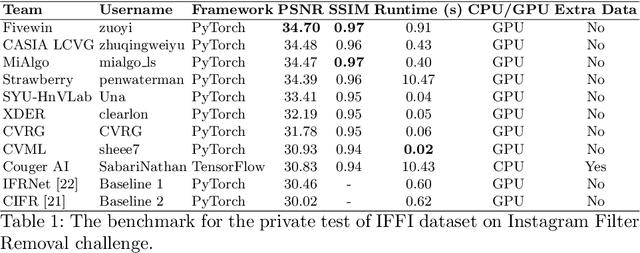

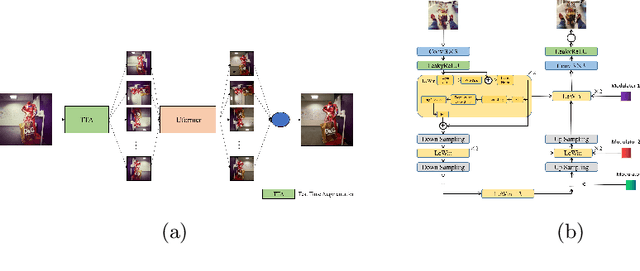

Abstract:This paper introduces the methods and the results of AIM 2022 challenge on Instagram Filter Removal. Social media filters transform the images by consecutive non-linear operations, and the feature maps of the original content may be interpolated into a different domain. This reduces the overall performance of the recent deep learning strategies. The main goal of this challenge is to produce realistic and visually plausible images where the impact of the filters applied is mitigated while preserving the content. The proposed solutions are ranked in terms of the PSNR value with respect to the original images. There are two prior studies on this task as the baseline, and a total of 9 teams have competed in the final phase of the challenge. The comparison of qualitative results of the proposed solutions and the benchmark for the challenge are presented in this report.
SAGAN: Adversarial Spatial-asymmetric Attention for Noisy Nona-Bayer Reconstruction
Oct 19, 2021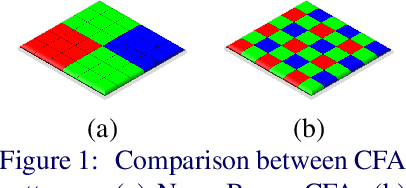



Abstract:Nona-Bayer colour filter array (CFA) pattern is considered one of the most viable alternatives to traditional Bayer patterns. Despite the substantial advantages, such non-Bayer CFA patterns are susceptible to produce visual artefacts while reconstructing RGB images from noisy sensor data. This study addresses the challenges of learning RGB image reconstruction from noisy Nona-Bayer CFA comprehensively. We propose a novel spatial-asymmetric attention module to jointly learn bi-direction transformation and large-kernel global attention to reduce the visual artefacts. We combine our proposed module with adversarial learning to produce plausible images from Nona-Bayer CFA. The feasibility of the proposed method has been verified and compared with the state-of-the-art image reconstruction method. The experiments reveal that the proposed method can reconstruct RGB images from noisy Nona-Bayer CFA without producing any visually disturbing artefacts. Also, it can outperform the state-of-the-art image reconstruction method in both qualitative and quantitative comparison. Code available: https://github.com/sharif-apu/SAGAN_BMVC21.
Beyond Joint Demosaicking and Denoising: An Image Processing Pipeline for a Pixel-bin Image Sensor
Apr 19, 2021
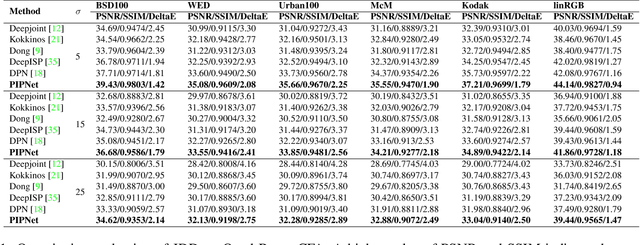

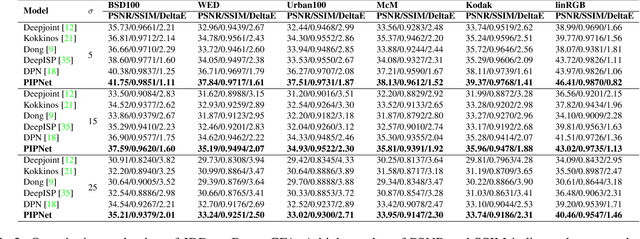
Abstract:Pixel binning is considered one of the most prominent solutions to tackle the hardware limitation of smartphone cameras. Despite numerous advantages, such an image sensor has to appropriate an artefact-prone non-Bayer colour filter array (CFA) to enable the binning capability. Contrarily, performing essential image signal processing (ISP) tasks like demosaicking and denoising, explicitly with such CFA patterns, makes the reconstruction process notably complicated. In this paper, we tackle the challenges of joint demosaicing and denoising (JDD) on such an image sensor by introducing a novel learning-based method. The proposed method leverages the depth and spatial attention in a deep network. The proposed network is guided by a multi-term objective function, including two novel perceptual losses to produce visually plausible images. On top of that, we stretch the proposed image processing pipeline to comprehensively reconstruct and enhance the images captured with a smartphone camera, which uses pixel binning techniques. The experimental results illustrate that the proposed method can outperform the existing methods by a noticeable margin in qualitative and quantitative comparisons. Code available: https://github.com/sharif-apu/BJDD_CVPR21.
A Two-stage Deep Network for High Dynamic Range Image Reconstruction
Apr 19, 2021
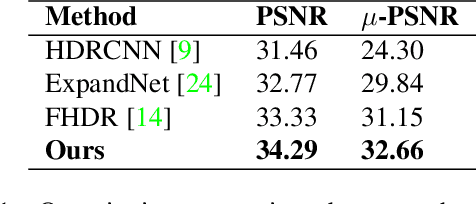

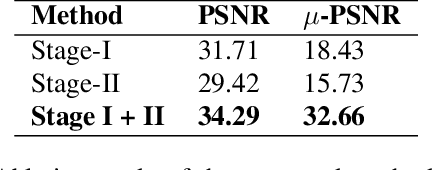
Abstract:Mapping a single exposure low dynamic range (LDR) image into a high dynamic range (HDR) is considered among the most strenuous image to image translation tasks due to exposure-related missing information. This study tackles the challenges of single-shot LDR to HDR mapping by proposing a novel two-stage deep network. Notably, our proposed method aims to reconstruct an HDR image without knowing hardware information, including camera response function (CRF) and exposure settings. Therefore, we aim to perform image enhancement task like denoising, exposure correction, etc., in the first stage. Additionally, the second stage of our deep network learns tone mapping and bit-expansion from a convex set of data samples. The qualitative and quantitative comparisons demonstrate that the proposed method can outperform the existing LDR to HDR works with a marginal difference. Apart from that, we collected an LDR image dataset incorporating different camera systems. The evaluation with our collected real-world LDR images illustrates that the proposed method can reconstruct plausible HDR images without presenting any visual artefacts. Code available: https://github. com/sharif-apu/twostageHDR_NTIRE21.
 Add to Chrome
Add to Chrome Add to Firefox
Add to Firefox Add to Edge
Add to Edge